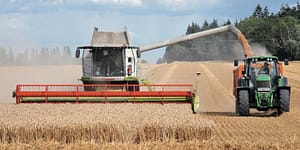How Beavers Can Save the World from Environmental Ruin

If you’re a loyal Chelsea Green customer, and haven’t been living in a dam for the last year, the likelihood that you’ve heard about Eager: The Surprising, Secret Life of Beavers and Why They Matter by Ben Goldfarb is high. But if you’re still not sure what all the hype is about, let us enlighten you.
Eager tells a powerful story about one of the world’s most influential species, how North America was colonized, how our landscapes have changed over the centuries, and how beavers can help us fight drought, flooding, wildfire, extinction, and the ravages of climate change. Ultimately, it’s about how we can learn to coexist, harmoniously and even beneficially, with our fellow travelers on this planet.
Intrigued now? Great! Because today we’re excited to announce the release of the paperback edition!
To celebrate, we’re sharing an article that first appeared in The Washington Post and was written by Barbara J. King. It has been adapted for the web.
Beavers, those paddle-tailed, buck-toothed dam-builders we know from local ponds and streams, create chaos. They pull down trees, cause creeks to flood and generally confound the human need for order and control. But in his new book, “Eager,” environmental journalist Ben Goldfarb makes a convincing case that we should change our view of this tumultuous behavior and recognize it for exactly what it is: animal engineering capable of restoring our ailing environment.
Subtitled “The Surprising, Secret Life of Beavers and Why They Matter,” the book shows the many contributions of this oily-coated rodent. Beavers create wetlands and make conditions favorable for many animals to thrive. Beaver ponds and meadows store carbon, which keeps it out of the atmosphere and thus helps counteract the rising temperatures associated with global warming. We must, Goldfarb contends, overcome our penchant for seeing beavers as pests — and too often killing them as a result — and instead recognize them as “the ultimate keystone species,” indeed as “the animal that doubles as an ecosystem.”

Beaver populations gradually diminished through a “three-century killing spree” that began in the 1500s and was exacerbated by demand for fur coats and hats. The ecological results were disastrous. “The disappearance of beavers,” Goldfarb writes, “dried up wetlands and meadows, hastened erosion, altered the course of countless streams, and imperiled water-loving fish, fowl, and amphibians.”
Where beavers are reintroduced and left to do their dam-building best, the positive effects on ecosystems may be considerable. To document these transformations, Goldfarb treks all over the United States, from Western wilderness areas to Walmart parking lots. In Washington state, under the direction of a biologist, he hikes up a creek to help release a pair called Sandy and Chomper to their new home. He attends the 10th Annual Martinez Beaver festival in California, where he interviews numerous “Beaver Believer” ecologists and activists, including inventors of flow-device tools that partially drain ponds or prevent beavers from damming up culverts and washing out roads, and thus save beavers’ lives. The result is a book that’s a most unexpected gift: a marvelously humor-laced page-turner about the science of semi-aquatic rodents.
Goldfarb concedes that it’s impossible to return to the golden age of a “magnificently ponded world” before widespread beaver trapping. But he shows how we can deploy nonlethal beaver management strategies, and relocate the animals to ailing habitats and let them do their thing. Consider what’s happened in Yellowstone National Park in the past few decades. Yes, the wolves reintroduced to the park in 1995 get the credit in viral news stories and videos about the “trophic cascade” in which the movement patterns of elk shifted, allowing aspen and willow to regenerate and creeks to deepen and thrive. What goes missing in this picture, though? Beavers, relocated first to the nearby Absaroka-Beartooth Wilderness Area and eventually emergent in Yellowstone. Their story usurped by the flashier wolves, the beavers significantly aid the willows’ regrowth; the trees’ roots are kept wet by way of beaver dams.
Elsewhere, beavers counteract some of the worst pollution from agriculture and fossil-fuel emissions. Along Maryland’s coastal plains, the presence of beavers means reduced pollutants like phosphorus and nitrogen. In Colorado’s Rocky Mountain National Park, “active beaver complexes” on 27 streams stored carbon in amounts equivalent to what 37,000 acres of American forest can do. Despite myths to the contrary, beaver dams don’t much impede fish navigation on rivers; most fish figure out a workaround. In fact, in beaver habitats, numbers zoom of the tiny invertebrates that make for fish food.
Unfortunately, enlightened policy toward beavers is in short supply. In 2016 alone, Goldfarb reports, the Wildlife Services arm of the U.S. Department of Agriculture killed 21,184 beavers. Washington state has become “the country’s most sizzling hotbed of castor relocation” because of a 2012 bill that promotes the live trapping and relocation of these animals. Yet even here, recreational trappers and people whose careers involve killing “nuisance” wildlife ensure the demise of more than 2,500 beavers annually. Even in the Beaver State, Oregon, the situation is dismal. Activism on behalf of beavers is starting to turn around these prejudices in some places, but progress is slow.
Goldfarb’s evident affection for beavers shines through the book. When he goes one-on-one with beavers, their individual personalities come through. Occasionally he gets carried away, as when he claims that because of intense wildlife management, Yellowstone’s animal residents are “hardly more self-willed than the orcas at SeaWorld.” Measure those orca tanks, and I doubt you will find that statement close to credible.
But here’s the take-home message: Goldfarb has built a masterpiece of a treatise on the natural world, how that world stands now and how it could be in the future if we protect beaver populations. He gives us abundant reasons to respect environment-restoring beavers and their behaviors, for their own good and for ours.
Eager accolades
PEN/E.O. Wilson Literary Science Writing Award Winner
For a book that exemplifies literary excellence on the subject of the physical or biological sciences and communicates complex scientific concepts to a lay audience.
The Washington Post – “50 Notable Works of Nonfiction”
“Can those paddle-tailed, buck-toothed dam builders offer humans some help in restoring our ailing environment?”
Science News’ – “Favorite Science Books of 2018”
“From tales about whales to enthralling scientific histories and the memoir of a frustrated astrophysicist, 2018 was a banner year for science books. Here are Science News’ picks for the titles that should be on any science lover’s bookshelf. ”
Booklist – “Top Ten Science/Technology Book of 2018”
“The best in popular-science writing reviewed in Booklist from December 1, 2017, to November 15, 2018, includes mind-whirling books on everything from black holes to the redrawn “tree of life” to dinosaurs, beavers, precision engineering, climate change, and space travel.”
The Seattle Times – The year in books: What Seattle Times arts writers read and loved in 2018
Forbes – Ten Of The Best Books About Climate Change, Conservation, And The Environment of 2018
“Written with clarity, intelligence, and humor, this engaging book will appeal to basically everyone.”
Recommended Reads
Badlands without Beavers: How Teddy Roosevelt became a conservationist
Recent Articles
Oxeye daisies are one of the most important plants for pollinators including beetles, ants, and moths that use oxeye daisies as a source of pollen and nectar. Instead of thinking about removing a plant like oxeye daisy, consider how you can improve the fertility and diversity of habitat resources in your home landscape, garden, or…
Read MoreThis long-lived perennial legume is used for forage and erosion control. Kudzu is edible with many medicinal uses and other applications. Pollinators of all kinds love its prodigious lavender blooms!
Read MoreMove aside, maple! We have two new syrups to add to the table. Read on for insights on tapping, selling, and eating syrup from walnut & birch trees.
Read MoreWhy is modern wheat making us sick? That’s the question posed by author Eli Rogosa in Restoring Heritage Grains. Wheat is the most widely grown crop on our planet, yet industrial breeders have transformed this ancient staff of life into a commodity of yield and profit—witness the increase in gluten intolerance and ‘wheat belly’. Modern…
Read MoreDid you ever wonder how leeks, kale, asparagus, beans, squash, and corn have ended up on our plates? Well, so did Adam Alexander, otherwise known as The Seed Detective. The following is an excerpt from the The Seed Detective by Adam Alexander. It has been adapted for the web. My Seed-Detective Mission Crammed into two…
Read More









